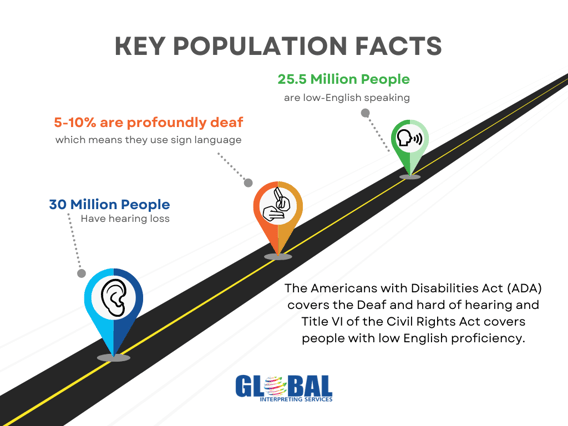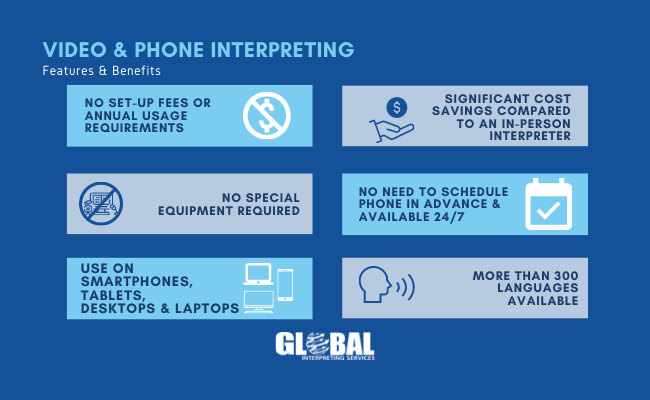An Officer pulls a car over and not only wonders what awaits them at the window…buts wonders if they will be able to communicate with the person at the window. Never before has communication been such a topic of discussion. Never before has cultural and disability diversity been so apparent…and social media been so widely used. You don’t want mistakes to be made; not only for your own professional livelihood, but also because you have a duty to uphold. This is the daily crossroads of a police officer on the street. This is also the challenge of the Administration of the Public Safety system. How do you comply with regulations and keep everyone safe?
Safety and communication are not just issues for the Officer on the street. There are communication barriers in jails, at the front desk, and in the call centers. Communication happens everywhere; it is inescapable. Those who meet the call to serve people will face a communication issue at some point in their career; whether it is a person with a disability, a person with a hearing loss, or a person who does not speak English. What you choose to do when this situation presents itself, is what makes you successful or not. What should you do? What can you do?
Some key facts:
- Interpretation is for verbal communication, and Translation is for written communication
- 30 million people in the U.S. have a hearing loss and 5 to 10% of them are profoundly deaf (meaning they are Sign Language users)
- Sign Language is NOT English in motion
- Deafness is never the problem in the eyes of the Deaf Community. The lack of awareness of the Deaf and their ways and communication needs is the obstacle to an efficient interaction.
- Deaf, hard of hearing people, and low English people, do not have a sticker on their license plates. These are “invisible” issues, and you must learn “cues” to recognize persons with Deafness, hearing loss and low English issues.
- 5 million people in the U.S. have Low English Proficiency (LEP).
- The Americans with Disabilities Act (ADA) covers the Deaf and hard of hearing and Title VI of the Civil Rights Act covers people with low English proficiency.
When communicating with the Deaf, hard of hearing, or low English proficiency (LEP), you historically had only one option: an in-person Interpreter. However, now there are technologies that enable your department to communicate quickly, easily, and inexpensively (compared to the cost of an in-person Interpreter). Over the Phone Interpreting (OPI) and Video Remote Interpreting (VRI) have truly allowed effective and efficient interpreting to happen everywhere a smart device can go.

In-Person Interpreting
Using an in-person Interpreter is always an option. With an on-site Interpreter there are scheduling issues, hourly minimums, and mileage fees. However, there are times when it is appropriate and necessary for an on-site face to face Interpreter. Complicated or lengthy interviews and court appearances are two examples. One of the key benefits on on-site interpreting is it is best for non-verbal communication as well as cultural issues.
However, when an Officer is in the field, in-person interpreting is not possible, but communication is just as important. You cannot have an Officer sitting on the side of a road waiting for an hour while your staff is calling around to find an Interpreter and then wait for an Interpreter to drive out to where they are parked for a 15-minute interaction. Not only does this not make sense, but it is also a waste of time and resources. In a jail setting, an Interpreter has to complete paperwork, have a guard assigned to them, have the inmate brought to them in shackles and have a room put aside for a sometimes short interaction. All of this adds up to time and money. What if there was a way to streamline the process by using a phone or computer with an Interpreter on it.
What is Video Remote Interpretation?
Using a video device such as a computer with webcam, smart phone or tablet you can connect remotely to an Interpreter in seconds. This service is used with the Deaf, hard of hearing or LEP communities. You have the smart device or computer in front of you, the person needing the Interpreter beside you. You go to a website or app and log in. An appointment is set up and you request the language. It’s that simple.
How Organizations Benefit from Video Remote Interpreting Services
- Fast Response for Urgent Situations – VRI allows you to provide a fast response for both spoken languages and deaf and hard-of-hearing clients/patients. When the need for communication is urgent, VRI provides an interpreter response in seconds.
- On-Demand Interpreting Solution - On-demand support means having access to professional interpreters 24 hours a day, 7 days per week, 365 days a year.
- Enhanced Accuracy – The visual support associated with Video Remote Interpreting can provide enhanced accuracy for spoken language over using OPI. The ability of the Interpreter to see body language, and the ability of the LEP to see the Interpreter’s body language. Also, hearing loss crosses all boundaries, perhaps the LEP has a hearing loss as well, and needs to read the lips of the Interpreter to fully understand them.
- Cost-Effective – Video remote interpretation fills the gap between over-the-phone and on-site interpretation services. Conventional on-site interpreting typically requires at least a two-hour minimum charge and possibly mileage and travel charges. VRI services can help optimize your interpretation budget while adding the benefit of visual support. When searching for a VRI provider, be sure to ask if there are hourly minimums associated with VRI technology. Additionally, some services require you to rent or purchase devices.
What is OPI Interpretation
Over-the-phone interpretation (OPI) is done by calling a phone number. You can do it by having the LEP and the English-speaking person in the same room and using a desk phone or smart device or by doing a conference call/3-way call and having all parties in a different location. Call a number, enter your PIN, and choose a language and an Interpreter is available for your call. Very easy.
Why use OPI Interpretation
Over-the-phone interpreting (OPI) tends to be the most accessible and quickest option in many situations. It usually affords the user the option of choosing from a full array of languages. This makes it a viable option for emergency and non-emergency situations. No scheduling is necessary when utilizing it. Therefore, it is ideal in field situations. OPI is also great for follow-up calls. Since no video screen is needed, it really is the most flexible option for ease of use. (Just not for Deaf and hard of hearing of course.) It can be used on any type of phone.

Benefits of video and phone interpreting for your department:
- Demonstrates your desire to engage and work with disabled and minority communities
- Protects your department legally (you complied with laws requiring you to be accessible)
- Increases your efficiency by better understanding the communities you serve
- Protects your cases from being dismissed due to ineffective communication or non-compliance with the ADA or Title VI.
Key Features to look for in a virtual interpreting provider
- Certified Interpreters
- Interpreters trained to work in the legal setting
- Tech support
- Wide selection of languages to choose from
- 24/7 Availability
- No special equipment
- No extra monthly or set-up fees
- Experience with Law Enforcement
While face-to-face interpreting will always have its place in law enforcement, Video and Phone interpreting are excellent tools to speed communication easily and inexpensively. They enable your department to be compliant with the ADA and Title VI as well as protect your department legally. Technology is available, and citizens are becoming more accustomed to using it every day. It is time to become fully accessible.
-1-1.png)



